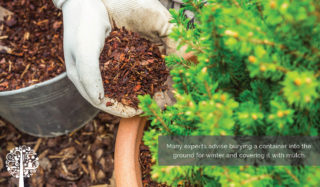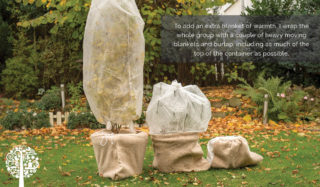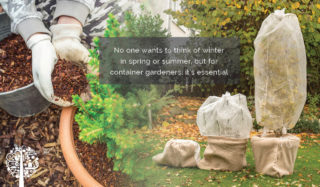Keeping Container Plants Warm In The Winter
For gardeners without a lot of space, container gardening is the answer! Roses, shrubs, and perennials can happily thrive in a pot all summer long, but when cold weather hits, things can get dicey. Bringing large container plants inside isn’t an option for the small-space urban gardener without a basement, greenhouse, or garage. As a small space gardener, I used to panic in winter, but over time, I’ve learned a few tricks that have helped all my container plants through the coldest winters.
Plan Ahead
No one wants to think of winter in spring or summer, but for container gardeners, it’s essential. When planting, it’s important to use a receptacle at least 15cm wider than the width of the root ball. This allows the dirt around the root to act as insulation much the same way it would in the ground. Metal, plastic, resin, and wood can withstand freezing temperatures, but terracotta, concrete, and ceramic pots are prone to cracking when left outside in sub-zero temperatures.
Hardiness
When choosing a plant for a year-round outdoor container, I always check the grower’s tag, particularly the plant’s hardiness. Picking a plant 10 – 15 degrees below the average temperature of my region may limit my selection of plants, but it also ensures the survival of the ones I have.
Acclimatize
When the first frost hits, container gardeners like myself get nervous, but it’s not time to jump into action. Temperature fluctuations in fall combined with shorter days send instructions to the plant to prepare for winter. Plants prepare by sending sap from the stocks into the roots to provide extra insulation. If sheltered and wrapped too early, the plant will become confused and unable to prepare for colder weather naturally. Waiting until temperatures stabilize before winterizing the container makes a huge difference.

Drainage And Elevation
It’s vital to ensure the container can drain well in the winter, so that melting snow and rain can run through it. Equally important is to make sure water does not freeze underneath it. Lifting the container off the ground with some pot feet or a stand creates airflow and enhances drainage.
Cluster And Wrap
Many experts advise burying a container into the ground for winter and covering it with mulch. For small-space gardeners without a backyard, this is impossible. So instead, I cluster all the containers with the most sensitive plants in the center. To add an extra blanket of warmth, I wrap the whole group with a couple of heavy moving blankets and burlap, including as much of the top of the container as possible.

At this point, I add a top dressing of soil mixed with organic compost and a layer of leaves as mulch. This adds extra insulation and nutrient value to the earth as the leaves decompose over the winter. To prevent foliage from getting frostbitten on evergreen shrubs in containers, such as camellia bushes or azaleas, burlap or canvas shrub covers are great.
The Great Water Debate
I cannot count the number of times neighbors have thought I was crazy for watering my containers in winter. But just as in summer, plants need water in the winter. A water-saturated container, even if it freezes, is much more beneficial to the survival of the plant, its health, and soil cohesion. A dry container during a freeze will leach soil nutrients and microbes. This soil erosion will leave the roots with nothing to feed off, and the plant may not survive. So go ahead and water those pots even in winter.
Winter can be a nail-biting time for container gardeners, but as long as you prepare for the worst and hope for the best, there’s a great chance everything will thrive come spring.





